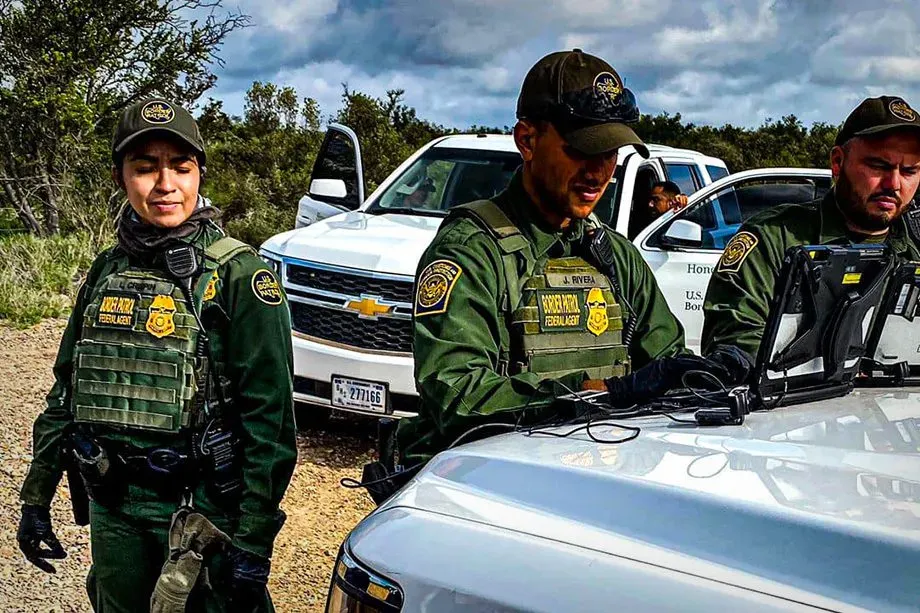U.S. border biometrics is taking a significant step forward as the government plans to photograph individuals leaving the country by vehicle at border crossings. This initiative, reported by WIRED, aims to enhance security through a biometric exit system that confirms departure from the United States. U.S. Customs and Border Protection (CBP) spokesperson Jessica Turner highlighted that the photographs captured at these crossings will be matched with travelers’ essential documents, such as passports and visas, ensuring rigorous travel document verification. This new measure will primarily affect lanes leading to Canada and Mexico, expanding on CBP’s existing practices that already include border crossing photography for inbound traffic. As the U.S. navigates border security, the implementation of this system raises important questions about privacy and the future of international travel.
The upcoming advancements in U.S. border biometrics, particularly the use of photographic technology for travelers departing the nation, signal a shift in border security mechanisms. By leveraging biometric data during exit processes, authorities aim to bolster identification measures and maintain safety at the Canada-U.S. border and beyond. This initiative marks a notable expansion in the ways travel documents are verified, as U.S. Customs and Border Protection adapts its strategies to encompass those leaving the country, not just those entering. Such enhancements reflect a growing trend in international security practices, emphasizing a thorough approach to both entry and exit monitoring as a foundational element of national integrity. As these changes unfold, they will undoubtedly influence perceptions of safety and accessibility for cross-border travelers.
Understanding the U.S. Border Biometrics Initiative
The U.S. Customs and Border Protection (CBP) is poised to enhance its security protocols by implementing a new biometrics system aimed at confirming the departure of individuals leaving the country by vehicle. This initiative marks a significant evolution of existing exit strategies, building upon the agency’s current practices at airports where biometric data, such as photographs and fingerprints, are routinely collected. As reported, the goal is to match these photographs at the border with travel documents like passports and visas to ensure accurate identification prior to leaving the U.S.
Currently, CBP does not monitor vehicle departures, marking this expected change as a pivotal move in border security management. This biometric exit system is part of a broader effort to tighten border control and enhance national security. Implementing such a system could streamline the verification process at the Canada-U.S. border and the southern U.S. border, assuring that individuals departing are accurately documented and accounted for.
Impact of Border Crossing Photography on Travelers
The new border crossing photography initiative will have significant implications for travelers leaving the United States, particularly those going to Canada and Mexico. This system aims not only to increase security but also to bolster the confidence of nations involved in cross-border travel. Travelers may need to prepare themselves for additional verification processes, including having their travel documents readily available for photographic verification when departing by vehicle.
While many travelers may view the added security measures positively, there are concerns about privacy and the overall experience of crossing the border. Some travelers might feel apprehensive about the constant monitoring and the implications it has for their personal data. The inclusion of biometric data collection at land borders may spark debates regarding privacy versus security, leading some individuals to reconsider their travel plans across these borders.
The Role of Travel Document Verification in Border Security
Travel document verification is a crucial part of border security, as it not only helps identify individuals but also plays a role in preventing illegal activities. With the introduction of biometrics at vehicle exit points, travel document checks will become even more important. U.S. Customs and Border Protection will utilize this technology to ensure that every individual departing the U.S. is verified against official documents like passports or visas, enhancing the integrity of border crossings.
Effective verification processes act as a deterrent for those attempting to cross borders without proper documentation. Furthermore, in a climate where safety concerns about travel to and from the U.S. loom large, verifying travel documents complements efforts to maintain national security. This assurance could help restore confidence among travelers who may be hesitant about their safety when traversing international boundaries.
Concerns Over International Travel Safety Amid Border Changes
Recent discussions surrounding safety while traveling to the U.S. have been amplified by concerns over new border security measures. A recent poll indicated that a significant percentage of Canadians now feel unsafe or unwelcome when considering travel to the United States, directly linking this sentiment to the enhanced security measures being implemented. Potential travelers may find themselves deterred from making cross-border trips due to these feelings, which can significantly impact the volume of tourism and commerce between the two nations.
This trend poses a challenge for both governments, as public perception has lasting ramifications on bilateral relations. Addressing these concerns and improving the travel experience for Canadians will be essential for the U.S. to ensure a vibrant exchange between the two countries. The new border biometrics system may need to include measures to convey to travelers that their safety and comfort are priorities, fostering goodwill while securing the border.
Potential Effects of Biometric Systems on Cross-Border Travel
Implementing biometric systems at border crossings will likely reshape the dynamics of how individuals approach international travel. As CBP moves towards adopting these technologies, travelers will need to familiarize themselves with new protocols and procedures. The biometric exit system could streamline processes, potentially reducing wait times and enhancing overall efficiency at border crossings as individual identities are verified swiftly and securely.
However, there are concerns that the introduction of more complex systems might lead to longer processing times at borders during initial rollouts, alongside frustration if travelers are unprepared for the changes. Education and clear communication from authorities about the new requirements will be crucial in easing fears and ensuring that travelers are well-informed and comfortable with their journey.
Introducing New Checkpoint Systems: Responses from Travelers
As new checkpoint systems are introduced, reports indicate varied reactions from travelers at the borders. Some individuals returning to Canada have expressed discomfort over additional inspections conducted by U.S. Customs and Border Protection, illustrating a potential friction point as travel policies evolve. Such experiences can foster a sense of unease among travelers, particularly regarding their treatment and privacy at border crossings.
Feedback from travelers will be instrumental in shaping how these new checkpoint systems are refined. Establishing a dialogue with the public about their experiences will help authorities adjust and improve border crossing procedures, ensuring that safety measures do not infringe upon the comfort or perceived fairness of the travel experience.
The Importance of Biometric Exit Systems in National Security
Biometric exit systems, such as those proposed for vehicular departures from the U.S., serve as critical components of national security infrastructure. By creating a robust database of individuals who leave the country, the U.S. Customs and Border Protection enhances its ability to track potentially harmful individuals and thwart potential criminal activity. The integration of biometric data into border control reinforces the notion that security measures must adapt and evolve in line with modern technological capabilities.
Moreover, these systems are essential in maintaining bilateral relationships with neighboring countries such as Canada and Mexico. By ensuring accurate records of who departs and potentially preventing unauthorized crossings, U.S. border management policies will enhance collaborative security measures across borders, further reducing risks associated with international travel.
How Public Perception Influences Border Security Policies
Public perception plays a fundamental role in shaping border security policies. As opinions about safety and welcoming attitudes toward foreign visitors fluctuate, lawmakers must consider this feedback when developing new initiatives like the biometric exit system. If significant segments of the population feel unsafe or unwelcome, it can lead to calls for reform and reconsideration of border practices that may exacerbate concerns.
The current discussions about travel from Canada to the U.S. showcase the delicate balance that policy makers must maintain between enforcing stringent security measures and ensuring an open environment for travelers. Engaging the public in these conversations can lead to more transparent efforts, allowing citizens to express their concerns while also fostering trust in the evolving security landscape.
Addressing Privacy Concerns with Enhanced Security Measures
As biometrics become an integral part of border security, privacy concerns are at the forefront of discussions regarding traveler data. Many individuals may feel apprehensive about how their biometric data—such as photographs collected during border crossings—will be handled and stored. Balancing security needs with privacy rights is vital for maintaining the public’s trust in these systems.
It’s critical for agencies like U.S. Customs and Border Protection to develop clear guidelines and policies related to the use of biometric data. Establishing transparent practices concerning data retention, access, and sharing will be essential in addressing these privacy concerns, helping travelers feel more secure about their personal information while still ensuring robust security measures are in place.
Frequently Asked Questions
What is the purpose of U.S. border biometrics in terms of travel document verification?
The purpose of U.S. border biometrics, particularly travel document verification, is to accurately confirm the identity of individuals as they exit the country. This system involves photographing travelers at border crossings, such as the Canada-U.S. border, and matching these images with their travel documents like passports and visas to ensure secure and efficient processing.
How will the biometric exit system at U.S. border crossings work?
The biometric exit system at U.S. border crossings will photograph individuals departing by vehicle and compare these photos against their travel documents. This process is designed to biometrically confirm departure from the U.S., enhancing the existing measures already in place for inbound travelers managed by U.S. Customs and Border Protection (CBP).
What are the expected implications of border crossing photography for travelers?
Border crossing photography is expected to enhance security by allowing U.S. Customs and Border Protection (CBP) to effectively monitor travelers leaving the U.S. This system will help in capturing important biometric data, thus aiding in the prevention of illegal activities and ensuring public safety at border entrances, particularly at the Canada-U.S. border.
Will the biometric exit system apply to travelers leaving for Canada and Mexico?
Yes, the biometric exit system is planned to impact outbound lanes at border crossings to both Canada and Mexico. This means that travelers exiting to either country will be subject to photographic documentation and biometric verification by U.S. Customs and Border Protection (CBP) to confirm their departure.
What similar practices does U.S. Customs and Border Protection currently use for incoming travelers?
U.S. Customs and Border Protection (CBP) currently photographs incoming travelers at border crossings and aligns these photos with their travel documents such as passports and green cards. This biometric data collection is a critical part of the agency’s efforts to ensure secure entry into the United States.
How might the implementation of a biometric exit system affect perceptions of safety for travelers?
The implementation of a biometric exit system could influence perceptions of safety for travelers, particularly for Canadians crossing into the U.S. Recent polls indicate concerns regarding safety and welcome attitudes among Canadians. How effective and unobtrusive this system is will play a significant role in shaping public sentiment about traveling to the United States.
What role do inspections play at U.S. border crossings during the exit process?
Inspections at U.S. border crossings play a vital role in national security. These process checks are designed to apprehend wanted individuals and seize contraband, ensuring that communities are safer. The forthcoming biometric exit system will complement these inspections by verifying identities of those departing the U.S.
Are there currently measures in place for monitoring vehicle departures from the U.S.?
As of now, the U.S. Customs and Border Protection (CBP) does not have a specific biometric exit program for travelers leaving the U.S. by vehicle, unlike the established systems at airports. However, the proposed expansion to include systematized vehicle monitoring aims to better secure the exit points at borders.
| Key Points |
|---|
| The U.S. is planning to photograph individuals leaving the country by vehicle at border crossings. |
| Purpose is to biometrically confirm departure from the U.S. |
| Photographic data will be matched with travel documents such as passports, green cards, and visas. |
| Currently, there is no program for monitoring vehicle departures; existing programs focus on air travel. |
| Recent polls show that a majority of Canadians feel unsafe and unwelcome traveling to the U.S. |
| Inspections at border crossings are part of national security efforts by U.S. Customs and Border Protection. |
Summary
U.S. border biometrics are set to enhance security measures by monitoring those exiting the country via vehicle. The proposed system aims to photograph individuals at border crossings and confirm their identities through biometric data linked to travel documents. As concerns grow among Canadians regarding their safety and welcome status when traveling to the U.S., implementing these measures could influence cross-border interactions significantly. This initiative by U.S. Customs and Border Protection underscores a broader trend of increasing biometric data collection, which could redefine the travel experience between the U.S. and its neighboring countries.




